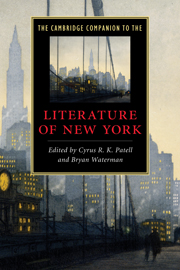Book contents
- Frontmatter
- Introduction
- 1 From British outpost to American metropolis
- 2 Dutch New York from Irving to Wharton
- 3 The city on stage
- 4 Melville, at sea in the city
- 5 Whitman’s urbanism
- 6 The early literature of New York’s moneyed class
- 7 Writing Brooklyn
- 8 New York and the novel of manners
- 9 Immigrants, politics, and the popular cultures of tolerance
- 10 Performing Greenwich Village bohemianism
- 11 African American literary movements
- 12 New York’s cultures of print
- 13 From poetry to punk in the East Village
- 14 Staging lesbian and gay New York
- 15 Emergent ethnic literatures
- Further reading
- Index
- Series list
7 - Writing Brooklyn
Published online by Cambridge University Press: 28 November 2010
- Frontmatter
- Introduction
- 1 From British outpost to American metropolis
- 2 Dutch New York from Irving to Wharton
- 3 The city on stage
- 4 Melville, at sea in the city
- 5 Whitman’s urbanism
- 6 The early literature of New York’s moneyed class
- 7 Writing Brooklyn
- 8 New York and the novel of manners
- 9 Immigrants, politics, and the popular cultures of tolerance
- 10 Performing Greenwich Village bohemianism
- 11 African American literary movements
- 12 New York’s cultures of print
- 13 From poetry to punk in the East Village
- 14 Staging lesbian and gay New York
- 15 Emergent ethnic literatures
- Further reading
- Index
- Series list
Summary
The child is already born, and is now living, stout and healthy, who will see Brooklyn numbering one million inhabitants! Its situation for grandeur, beauty, and salubrity is unsurpassed probably on the whole surface of the globe; and its destiny is to be among the most famed and choice of the half dozen of the leading cities of the world. And all this, doubtless, before the close of the present century.
Walt Whitman, “Brooklyniana: No. 17” (1862)Crowds of men and women attired in the usual costumes, how curious you are to me!
On the ferry-boats the hundred that cross, returning home, are more curious than you suppose,
And you that shall cross from shore to shore years hence are more to me, and more in my meditations, than you might suppose!
Walt Whitman, “Crossing Brooklyn Ferry” (1860)In an 1862 article in the Brooklyn Standard, Walt Whitman imagined, less than four decades hence, Brooklyn's prominence among the cities of the world. At the time of his writing, Brooklyn was the United States' third largest city. Home to more than 260,000 people, Brooklyn rivaled New York, its neighbor across the East River, in size, industry, and population. Residents lived and worked on densely populated streets designed in 1839 as a grid; they rode the numerous ferries that daily crossed the East River. In an earlier article in the six-month series entitled “Brooklyniana,” Whitman envisioned among future generations a widespread interest in the narratives of Brooklyn's diverse inhabitants, their stories of daily life, “personal chronicles and gossip,” and most of all their “authentic reminiscences” and “memoirs” of urban life. Whitman was prescient. 1 Although it is no longer its own city – the consolidation into Greater New York City occurred in 1898 – Brooklyn’s inhabitants and landscape are a recognizable and indeed iconic element of American arts and letters.
- Type
- Chapter
- Information
- The Cambridge Companion to the Literature of New York , pp. 109 - 120Publisher: Cambridge University PressPrint publication year: 2010
- 1
- Cited by



